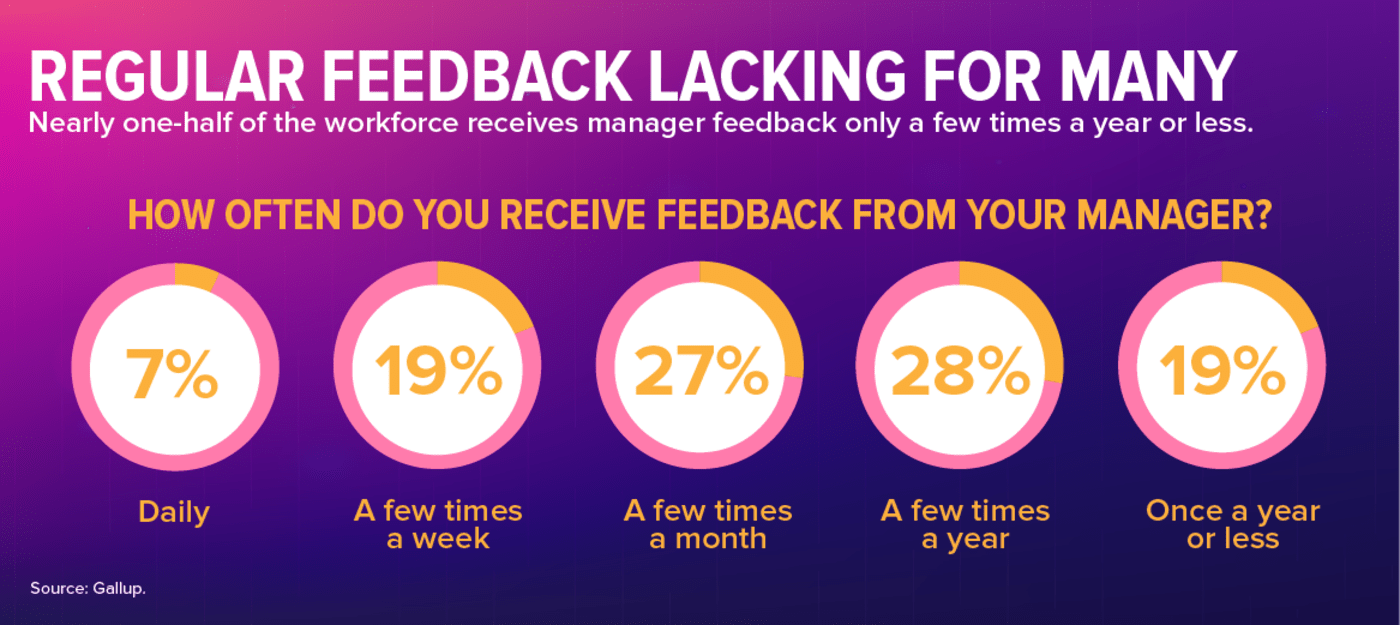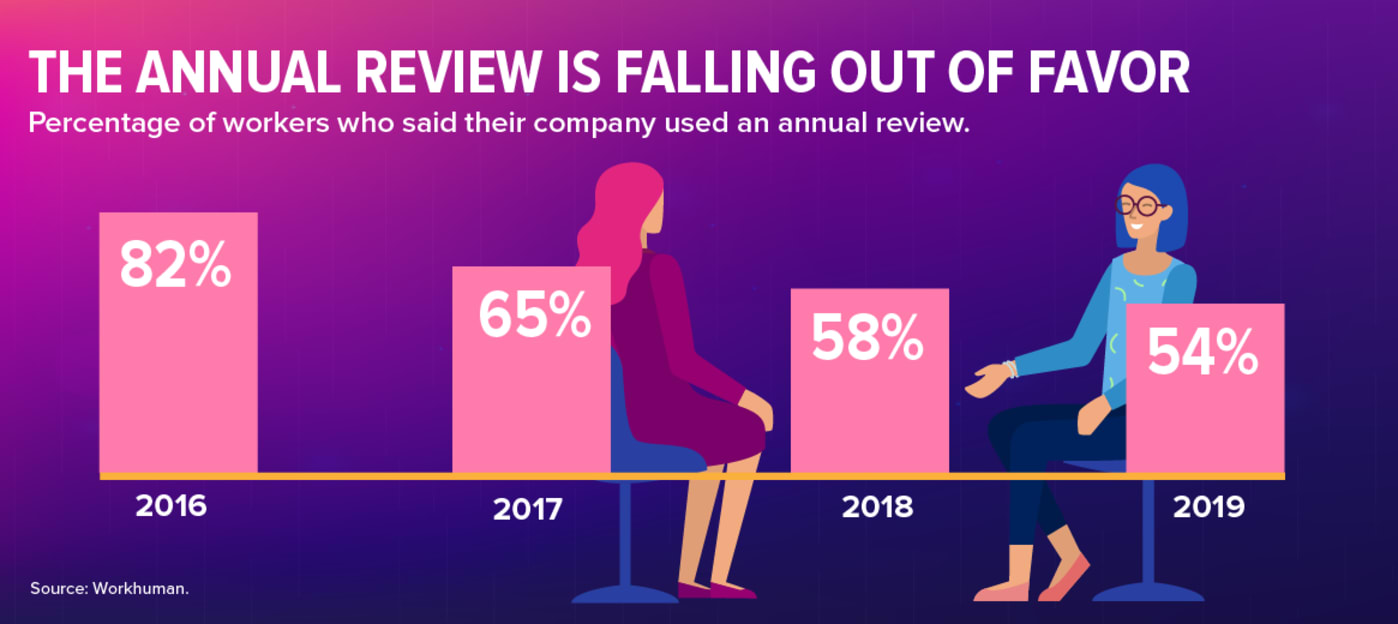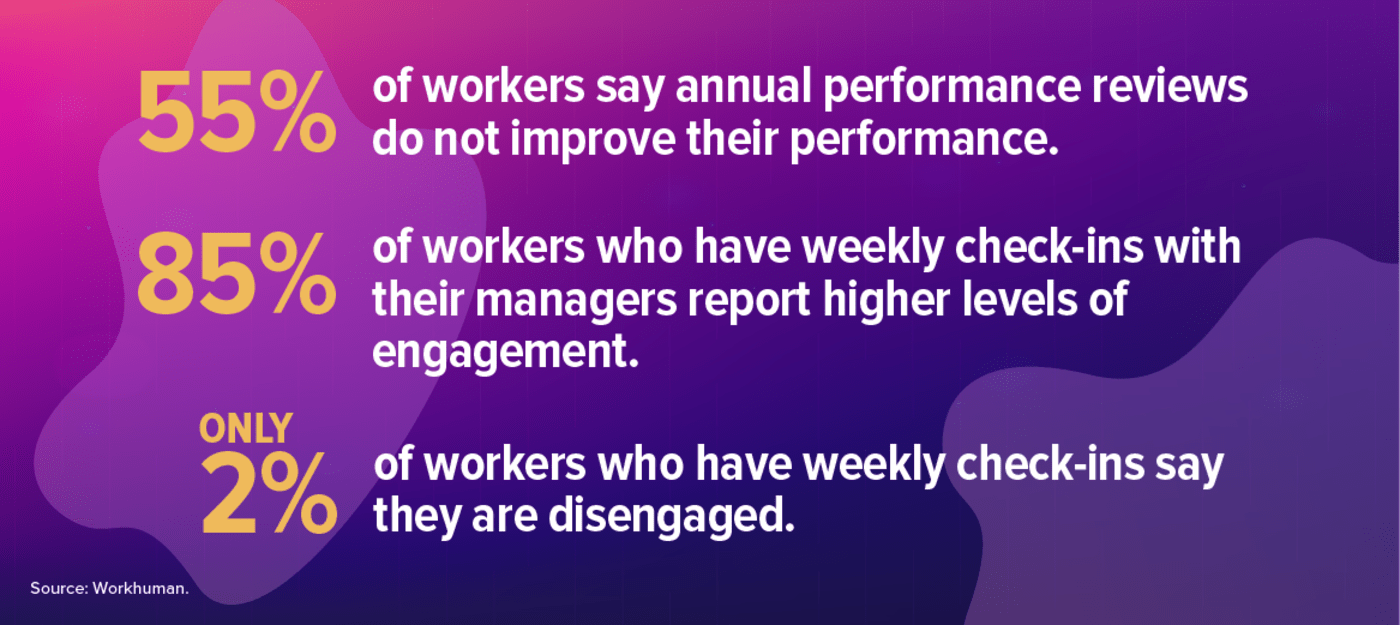Transforming Performance Management into Continuous Feedback
Annual appraisals are falling out of favor as companies open lines of communication and provide regular feedback and coaching to workers.

Most workers value candid discussions on workplace performance. They want regular and more-transparent performance feedback. But employees don't believe that management has a good grasp of performance assessments and related guidance.
Sometimes the review process does more harm than good. According to a 2019 study from Gallup, only about 10 percent of U.S. workers felt engaged after receiving negative feedback on the job. And nearly 30 percent were so put off by a negative review that they began actively looking for a new job. Moreover, 55 percent of workers believe annual reviews don't improve their performance, according to a 2019 Workhuman Analytics & Research study.
So, it's not surprising that the number of companies conducting annual or semiannual reviews has fallen in recent years. "The traditional performance-management approach has become outdated," says Rosette Cataldo, vice president of performance and talent strategy at Workhuman, a human capital management software company.
Some companies have begun moving toward providing continuous, real-time feedback throughout the year. "This new-and-improved model is reflective of how work actually gets done and leads to increased engagement," Cataldo says.
Navigating Performance Management in the Modern Workplace
If you ask a workplace expert—or an employee, for that matter—what's wrong with the performance-review processes, the answer might be, "Where do I start?"
"The challenge with annual reviews is that they're a collection of indirect, out-of-context feedback that a supervisor or boss is supposed to deliver long after a project has ended, so the feedback is no longer educational or useful," says Susan Clarke, co-founder of Thrive, a coaching and consulting firm in Whitefish, Mont.
"Feedback is scary to many," says CrisMarie Campbell, Thrive's other co-founder. "People often think it means that they did something wrong or that the other person is mad at them." And that may be why we avoid giving that feedback in real time, she says.
Feedback is more effective when check-ins are frequent. "That way, you're able to clarify expectations before a team member or colleague gets too far ahead in a task or a project," Campbell says. And workers who check in with their manager at least weekly are five times less likely to be disengaged than those who never check in, Workhuman found.

Evidence is growing that organizations are getting better at recognizing and valuing staff members, with the approach shifting in two significant ways, according to Kyle Brost, chief executive officer at Spark Policy Institute, a Denver-based business consultancy that specializes in corporate employee engagement tools and strategies.
"First, leaders are looking for more ways to use data," Brost says. "Feedback can be very subjective and lack context. For this reason, leaders are turning to more data sources to inform feedback."
That approach offers several advantages. "Data emphasizes both individual contributions and organizational processes that are working, along with any misalignments between the two," Brost says. "Additionally, the sources and means for collecting this data are becoming increasingly accessible, human-centered and user-friendly." For example, data software packages such as 7Geese, Bamboo HR, CRG emPerform, Officevibe and Saba Cloud all have tools to help managers provide feedback on a regular, year-round basis.
Second, the old approach to feedback as a one-way street, where the organization's leaders are all-knowing and the employees just need to get up to speed, is quickly dissolving.
"Individual perspective, expertise and value are being recognized at a greater level than ever before," Brost says. "This means that feedback is no longer about the organization simply talking at the employee. It's becoming a two-way street where individuals are able to bring feedback to the organization."
But we're not there, yet. he says, "The structure, intent and outcomes of feedback still need to shift to align with this more accurate and valuable approach."
Embracing Shorter Feedback Cycles for Performance Management
One trend companies are turning to is a tighter feedback calendar cycle. Consequently, the once-yearly employee review is falling out of favor.
In 2016, 82 percent of workers surveyed said their company used an annual review. That number dropped to 65 percent in 2017, 58 percent in 2018 and 54 percent in 2019, according to the Workhuman report.
"Feedback will become more informal, more iterative and more frequent," says Karen Crone, chief human resource manager at Paycor, a human capital management company.
Paycor has 12-week performance discussion cycles called "CONNECT sessions," according to Crone, which better mirror the company's business model and include employee reviews.
"Think about it as a 12-week year," she says. "In that regard, our employee discussions don't require a laborious form, but rather a quick-hit review of what's been accomplished, what's next and how the person is developing. That way, the employee and the manager have an equivalent voice in preparing for the conversation."
Paycor wants its employee feedback sessions to be "informal, iterative, frequent and balanced," Crone says, with managers and employees sharing responsibility for the reviews. "For companies to be agile, feedback must get closer to real-time."

Employees are encouraged to take an active role in the process. "As more work is completed in self-guided teams, team members take more responsibility for feedback," she says. "The manager continues to be the focal point for career conversations, with performance assessment coming from the team, and team members holding one another accountable, supporting one another when there are obstacles and pointing out missed expectations."
Internal Feedback Tools and the Future of Performance Evaluations
Some companies are following suit and developing their own employee-centric evaluation models that don't look like the "one-and-done" evaluation model that old-line companies were doing decades ago.
"At PwC, we believe in the power of frequent, informal feedback," says Rod Adams, U.S. and Mexico talent acquisition leader at the consultancy. "Allowing for regular feedback conversations, versus the traditional annual review, helps individuals to maximize their strengths, quickly close gaps, and drive learning and development in real-time throughout the year."
PwC has accelerated that process with its own real-time feedback tools.
"We have developed what we call the PwC Professional for real-time feedback," Adams says. "All our staff are recruited, developed and managed against the PwC Professional's five attributes for leadership, which are whole leadership, business acumen, technical capabilities, global acumen and relationships."
The PwC feedback model allows managers to leverage a 360-degree feedback program with performance management and career development tools that gather insights from everyone in the workplace—managers, peers and subordinates. Data is collected through a combination of surveys, reports, and coaching and collaboration tools. PwC also tracks feedback over time and charts progress across the five areas of leadership, he says.
The company conducts regular staff engagement surveys, Adams says, and the employee response to the real-time feedback culture is overwhelmingly positive. "It's a win-win for everyone, allowing for real opportunities to learn on the job while also encouraging leadership at all levels."
Communication in a Crisis
When the threat of the coronavirus became apparent earlier this year, feedback became much more difficult at companies across the country.
"Working apart from your team is very challenging as you're not sure of their progress and how things are going," says Michael Lowe, CEO at CarPassionate.com, an auto parts web platform based in Phoenix. "It's easier at the workplace, where you can go visit an employee on the job or they can come to you and discuss productivity or chat about plans." When working remotely, Lowe stressed the need for the right tech tools and software to better connect with employees.
"Providing employees with good feedback shouldn't be a challenge if you're using the right assessment tools [such as employee evaluation platforms] and communication tools [like videoconferencing]," says Pete Sosnowski, co-founder at Zety, a job search platform based in Warsaw, Poland.
"Remote work requires an increased focus and motivation to maintain productivity," Sosnowski says. "There are many factors that can disrupt standard work activities, from the unsuitable work environment, the presence of family members and distractions, to lack of work peers and managers."
To overcome those disruptions, he recommends that companies provide frequent feedback. For example, instead of quarterly reviews, he suggests aiming for monthly or biweekly feedback.
Managers can also solicit feedback from workers. "As a manager, you're put in a completely new situation, as well, in managing a remote team," Sosnowski says. "You should use feedback from your team members to see how you're handling this new situation."

When providing feedback and direction remotely, clarity must be a priority, says Jake Penney, head of human resources at English Blinds, an online blinds and home decor company based in Solihull, England. "During the COVID-19 crisis, providing feedback remotely and ensuring that the right message gets across can be challenging," he says, "because there's so little context and tone for such remote interactions." He recommends speaking by phone or video conferencing to personalize feedback and reduce the chances of misunderstandings.
The Rise of Real-Time Feedback in Performance Management
What will reviews look like in the future? Certainly, time-honored traditions such as meaningful face-to-face interactions (even if it's via Skype) will prevail—with a heavy dose of 21st century technology added into the mix.
"The annual performance review is a retrospective, and looking backward over a full year can be useful," says Michael L. Zirulnik, executive director of The Varsity Project, a communication consultancy in Phoenix, Ariz. "But without context, it's often too distant for us to do much of anything with, and employees may walk away unhappy."
That's why more companies are leveraging increased technological feedback in task-oriented environments.
"For instance, on the flight deck of an aircraft, there are dozens of tech tools offering pilots feedback they can use immediately to improve the performance of the aircraft and how they fly," Zirulnik says. "If you're a pilot or a surgeon getting real-time feedback from technological tools that enables safe operation, the feedback is almost always accepted."
Companies such as Starbucks and Arizona's Motor Vehicle Division have introduced real-time feedback tools in most of their stores and service locations, Zirulnik says. "These tools indicate, among other metrics, how well the employees are delivering product to the customer … It's an effort in creating efficiency to service a predetermined number of people per minute or per hour."
But what about feedback in settings that aren't as task-oriented? "With respect to office environments or creative tasks, it means having a leader that finds the time to review, assess and consult with employees regularly," Zirulnik says.
It may be time-consuming, but there's no substitute for interpersonal relationships where meaningful feedback is communicated—and that's where real-time feedback tools can help.
But not all employees relish real-time feedback, at least as it's presently structured.
To change that, organizational cultures need to shift, Zirulnik says. "Feedback needs to be treated as an employee empowerment tool and not as a punitive measure."
The business benefits of that are numerous. "Organizations that offer feedback as a matter of employee success and not as a means to discipline will tend to have a healthier culture," Zirulnik says, "with more productive, happier, efficient employees."
Brian O'Connell is a freelance writer based in Bucks County, Pa.
Explore Further
SHRM provides advice and resources to help employers better manage and assess employee performance.
Performance Management Platforms Are Keeping Pace with Appraisal Trends
Reinvented performance management systems are designed to deliver more real-time feedback to enhance employee coaching and development.
Viewpoint: How to Collect Continuous Feedback
Emerging communication technologies offer organizations and employees the ability to exchange meaningful real-time feedback.
Don’t Confuse Feedback with a Performance Appraisal
Feedback and performance appraisals are not one and the same. While there may be some similarities between the two, they are fundamentally different.
SHRM Resource Page: Performance and Discipline
The topic of performance management can bring dread to managers and employees alike. But a successful system can positively impact the bottom line, provide a path for achieving goals and increase employee morale.



